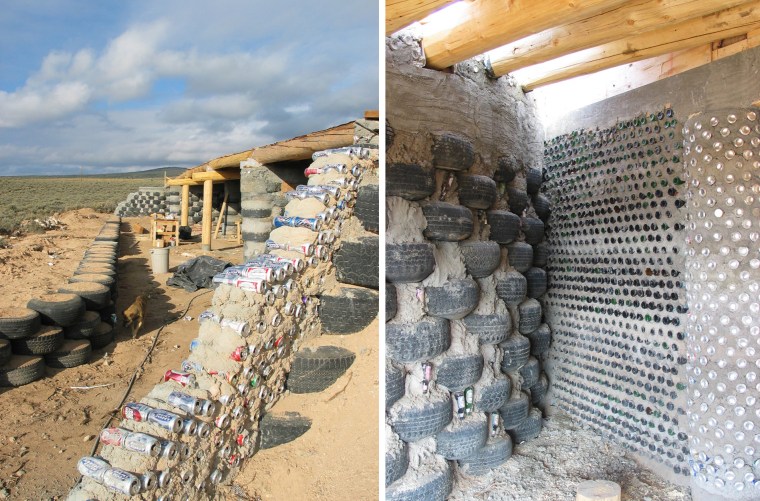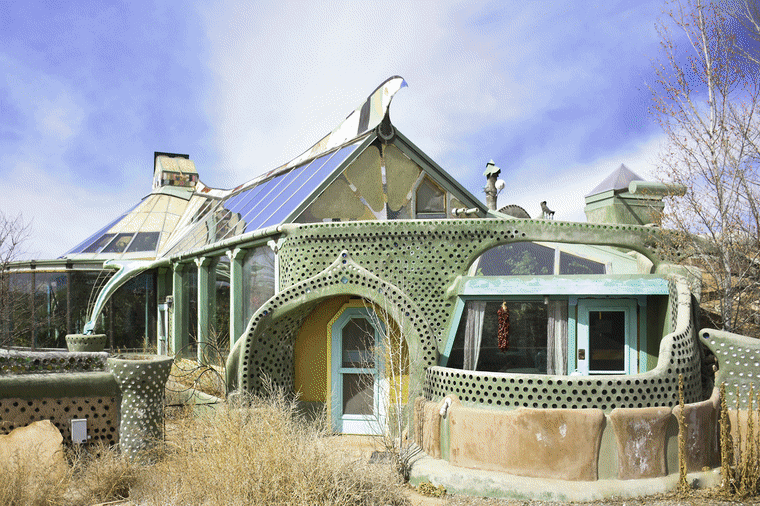TAOS, New Mexico — Old tires, crumpled cans and empty wine bottles are piling up at construction sites across the desert. A renewed purpose awaits these discarded items, which will become the building blocks for new, hypersustainable homes.
The tires and cans are stacked into towers and embedded in cement to create a structure’s foundation, while multicolored bottles create the appearance of stained glass on the walls. The designs look otherworldly, but the original architect, Michael Reynolds, calls them “Earthships.” His goal is for the homes to be completely climate friendly by doing more than just recycling items.

“People have this idea of what a house is, but this is a machine to live in, one that encounters the phenomena of the planet to give you everything you need, free,” Reynolds said during a recent tour of his newest Earthship designs. “It’s resilient, made to deal with the world around it.”
Six elements define an Earthship, according to Reynolds. It must be built with natural and repurposed materials, use thermal or solar heating and cooling, get electricity from solar and wind energy, harvest and reuse rainwater, have its own contained sewage treatment, and enable owners to grow or produce their food on-site.
The desert surrounds the Earthship community, with snowcapped mountains in the distance and bright sun shining down most days.
As Reynolds toured the site, fat drops fell from the moody sky and wind whipped around him as he smiled.
“When it rains, I’m happy because I’m getting water, not in a plastic bottle,” he said. “I’ve got it no matter what happens to the stores or to the deliveries.”
Captured rainwater is initially used to shower or run the washing machine before filtering through the home’s water system and used to flush the toilet. Then it can be used to feed the garden or plants.
Earthships are designed to be self-contained and run off the power grid. They’re built with at least 40 percent recycled material and utilize one-sixth the power of a regular home. Reynolds said owners can be as sustainable or traditional as they want, which has led some critics to argue the concept is misleading if all the homes aren’t 100 percent sustainable.

But that flexibility is appealing to students who travel from across the country and the world to attend the Earthship Academy, an on-site course that teaches participants about the water systems, solar and wind energy, and indoor farming while providing hands-on instruction. They also practice building elements of their own Earthships.
Student Martin Alan Huff, who works in the wind industry in Joliet, Illinois, said he sees the ability to rely on your own home for energy rather than on a power grid as a “positive change for the housing and construction industry.”
“Every single house in the future could be its own little power plant,” he said, “so that would be a step in the right direction.”
Huff said he would like to build his own Earthship, but he would have to move because permitting restrictions in Illinois don’t allow certain building materials used in the structures.
Other students said they want to take small pieces from the course home with them.
“I’m excited about the opportunity to implement certain concepts from this course into the conventional housing that already exists in cities and towns,” said Dries Verberkmoes, an architect who traveled from Belgium to attend the workshop. “It will be worth trying to save on energy. The energy costs are going up every day. And I think it’s quite scary for a lot of people.”
Reynolds’ idea originated more than 50 years ago, and the early Earthships he built sat empty because few people were interested. But demand is growing: Structures have been built in 35 states and internationally.

Reynolds said people are attracted to the concept because “humanity is being bombarded” by the economy and the Covid-19 pandemic, as well as the increasing frequency of climate disasters and fear and uncertainty about the war in Ukraine.
He said Earthships could protect families from emergencies like the 2021 winter storms in Texas that left people without power for days, and his company has started building in areas recently hit by tornadoes and hurricanes, including southeastern Kentucky and Puerto Rico.
The structures are designed to be more resistant to hurricanes, tornadoes and floods, allowing them to serve as emergency shelter while operating independently from a downed power grid.
“It’s very late to solve for climate change, but it’s not too late,” Reynolds said. “This is just a different way of looking at life on this planet. This is an option for a life raft … really, a life yacht.”